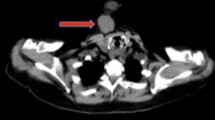Abstract
Purpose
Solitary fibrous tumours (SFTs) are rare, mesenchymal neoplasms. The purpose of this study was to analyse the radiological and clinicopathological features of SFTs in the extracranial head and neck region.
Materials and methods
We retrospectively reviewed the clinical, computed tomography (CT), magnetic resonance imaging (MRI), and pathological features in 18 patients (12 men and 6 women), aged 18–75 years, with histologically proven SFTs in the extracranial head and neck region. Fourteen patients underwent CT scanning and nine underwent MRI. The histological techniques included routine haematoxylin-eosin staining and immunohistochemical analysis. Clinical data were retrieved from the medical records.
Results
Most tumours presented as a slow-growing painless mass. Eighteen SFTs arose in the orbit, cheek, masticator space, the parapharyngeal space, infratemporal fossa, maxillary, submandibular space and the parotid gland, respectively. All 18 lesions were found as a solitary mass, ranging in size from 1.2 to 6.8 cm (mean 3.57 cm). They mostly presented with an ovoid shape, with well-defined margin, and isodensity on plain CT, isointensity on T1-weighted imaging, mild hyperintensity on T2-weighted imaging and diffusion-weighted imaging, and marked heterogeneous enhancement on contrast-enhanced CT and MRI. The time-intensity curves (TICs) exhibited a rapidly enhancing and slow washout pattern on dynamic contrast-enhanced MRI and dual-phase CT. Imaging findings of the SFTs depended on the histopathological components.
Conclusion
SFTs most commonly present with an asymptomatic mass in adults. A solitary, ovoid and well-defined mass with strong enhancement after contrast agent injection is suggestive of this diagnosis. Rapidly enhancing and slow washout pattern TICs may be additional valuable features.





Similar content being viewed by others
Abbreviations
- SFTs:
-
Solitary fibrous tumours
- CT:
-
Computed tomography
- MRI:
-
Magnetic resonance imaging
- DWI:
-
Diffusion weighted imaging
- DCE:
-
Dynamic contrast enhanced
References
Lahon B, Mercier O, Fadel E et al (1012) Solitary fibrous tumor of the pleura: outcomes of 157 complete resections in a single center. Ann Thorac Surg 94:394–400
Gold JS, Antonescu CR, Hajdu C et al (2002) Clinicopathologic correlates of solitary fibrous tumors. Cancer 94:1057–1068
Demicco EG, Park MS, Araujo DM et al (2012) Solitary fibrous tumor: a clinicopathological study of 110 cases and proposed risk assessment model. Mod Pathol 25:1298–1306
Kim HJ, Kim HJ, Kim YD et al (2008) Solitary fibrous tumor of the orbit: CT and MR imaging findings. AJNR Am J Neuroradiol 29:857–862
Yang BT, Wang YZ, Dong JY et al (2012) MRI study of solitary fibrous tumor in the orbit. AJR Am J Roentgenol 199:506–511
Chen H, Xiao CW, Wang T et al (2012) Orbital solitary fibrous tumor: a clinicopathologic study of ten cases with long-term follow-up. Acta Neurochir (Wien) 154:249–255
Cox DP, Daniels T, Jordan RC (2010) Solitary fibrous tumor of the head and neck. Oral Surg Oral Med Oral Pathol Oral Radiol Endod 110:79–84
Knosel T, Schulz B, Katenkamp K et al (2010) Solitary fibrous tumor and haemangiopericytoma: what is new? Pathologe 31:123–128
Ginat DT, Bokhari A, Bhatt S et al (2011) Imaging features of solitary fibrous tumors. AJR Am J Roentgenol 196:487–495
Bowe SN, Wakely PE Jr, Ozer E (2012) Head and neck solitary fibrous tumors: diagnostic and therapeutic challenges. Laryngoscope 122:1748–1755
Ganly I, Patel SG, Stambuk HE et al (2006) Solitary fibrous tumors of the head and neck: a clinicopathologic and radiologic review. Arch Otolaryngol Head Neck Surg 132:517–525
Khandelwal A, Virmani V, Amin MS et al (2013) Radiology–pathology conference: malignant solitary fibrous tumor of the seminal vesicle. Clin Imaging 37:409–413
Kim HJ, Lee HK, Seo JJ et al (2005) MR imaging of solitary fibrous tumors in the head and neck. Korean J Radiol 6:136–142
Clarencon F, Bonneville F, Rousseau A et al (2011) Intracranial solitary fibrous tumor: imaging findings. Eur J Radiol 80:387–394
Tanaka A, Mihara F, Yoshiura T et al (2004) Differentiation of cavernous hemangioma from schwannoma of the orbit: a dynamic MRI study. AJR Am J Roentgenol 183:1799–1804
Xian J, Zhang Z, Wang Z et al (2010) Evaluation of MR imaging findings differentiating cavernous haemangiomas from schwannomas in the orbit. Eur Radiology 20:2221–2228
Acknowledgments
The authors thank Henghua Zhou for her help in pathology. This work was supported by grants from National Natural Science Foundation of China (81272802) and Shanghai Young Doctor Training Scheme.
Conflict of interest
Yu Liu, KaiCheng Li, Huimin Shi, and XiaoFengTao declare no conflict of interest.
Author information
Authors and Affiliations
Corresponding author
Additional information
Y. Liu and K. Li contributed equally to this work.
Rights and permissions
About this article
Cite this article
Liu, Y., Li, K., Shi, H. et al. Solitary fibrous tumours in the extracranial head and neck region: correlation of CT and MR features with pathologic findings. Radiol med 119, 910–919 (2014). https://doi.org/10.1007/s11547-014-0409-9
Received:
Accepted:
Published:
Issue Date:
DOI: https://doi.org/10.1007/s11547-014-0409-9




